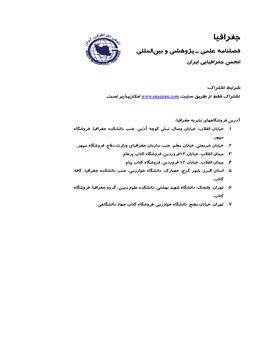The Study of Urban Textures Vulnerability against the Earthquake Crises (Case study: Region 8 Municipality of Tabriz)
Subject Areas :
1 -
2 -
Keywords: Vulnerability, Earthquake, Tabriz, Urban Fabric, ANP Model,
Abstract :
One of the issues that most cities of the world are involved is natural disasters.The need to reduce vulnerability of cities against natural disasters such as earthquakes can be considered as one of the main objectives of urban planning and urban designing.Therefore, the present study aims to identify the vulnerable pieces of district 8 of Tabriz against earthquake.In this study, 9 indicators of population density, building density, land usage, microlithicity, access to relief centers, open space, quality of materials, quality of buildings and distance from risk making centers were selected.Then, by the use of ANP method and combining the related criteria in GIS environment, vulnerability of the district 8 of Tabriz was investigated.The results showed that more than 43% of the parts of district 8 of Tabriz have high and very high vulnerability against earthquake that high vulnerability can be seen in old quarters due to the very narrow and dead-end passages, small and breakable parts, old buildings with less durable materials and neglected building privacies.According to the zoning map, about 15.84 percent had average vulnerability and 29.94 percent less vulnerability.Considering the vulnerability of the district, proper planning to organize the mentioned buildings is needed.
بحريني، سيدحسين( 1375)، برنامه¬ريزي كاربري زمين در مناطق زلزله¬خيز، نمونه شهرهاي منجيل، لوشان، رودبار، انتشارات بنياد مسكن انقلاب اسلامي، تهران؛
2. پوراحمد، احمد؛ لطفی، صدیقه؛ فرجی، امین و آزاده عظیمی(1388)، بررسی ابعاد پیشگیری از بحران زلزله (مطالعه موردی:شهر بابل)، مجله مطالعات و پژوهش¬های شهری و منطقه¬ای، سال اول، شماره اول، ص24-1؛
3. پورمحمدی، محمدرضا و علی مصیب¬زاده (1387)،آسیب¬پذیری شهرهای ایران در برابر زلزله و نقش مشارکت محله¬ای در امدادرسانی آنها، مجله جغرافیا و توسعه، شماره 12، صص 117-144؛
4. تقوایی، مسعود و نرگس علیمحمدي (1385)، زلزله و پیامدها و بحران¬هاي ناشی از آن در شهرها، نشریه بنا، شماره 27،ص83-107؛
5. حبیبی، کیومرث؛ احمد پوراحمد؛ ابوالفضل مشکینی؛ علی عسگري و سعید نظري عدلی (1387)، تعیین عوامل ساختمانی موثر در آسیب¬پذیري بافت کهن شهري زنجان با استفاده ازGIS FUZZYLOGIC، نشریه هنرهای زیبا، شماره 33، ص 27-23؛
6. زارع، مهدي (1380)، خطر زمين لرزه و ساخت¬وساز در حريم گسل شمال تبريز و حريم گسلش گسل¬هاي زمين لرزه¬اي ايران. پژوهشنامه زلزله¬شناسي و مهندسي زلزله، سال چهارم. شماره دوم و سوم، ص 46-57؛
7. زبردست، اسفندیار (1389)، کاربرد فرآیند تحلیل شبکهای (ANP) در برنامهریزی شهری و منطقهای، نشریه هنرهای زیبا، دوره 2، شماره 41، ص90-79؛
8. صیامی، قدیر، تقی¬نژاد، کاظم و علی¬ زاهدی کلاکی (1394)، آسیب¬شناسی لرزه¬ای پهنه¬های شهری با استفاده از تحلیل سلسله مراتبی معکوس(IHWP) و GIS مطالعه موردی شهر گرگان، فصلنامه مطالعات برنامه¬ریزی شهری، سال سوم، شماره نهم، ص43-63؛
9. عباس¬نژاد، احمد و محمد داستانپور (1387)، زلزله¬ها و زلزله¬خیزی استان کرمان، سازمان مسکن و شهرسازی استان کرمان، خدمات فرهنگ کرمان،کرمان
10. فرجي ملائي، امين و مهدي قرخلو (1389)، زلزله و مديريت بحران شهري مطالعه موردي شهر بابل، “فصلنامه جغرافيا”، سال هشتم، شماره 25، ص 143-164؛
11. کیال، امیر و مهدیه عقیلی(۱۳۸۸)، تحلیل و بررسی مکانیابی ایستگاه¬های آتش¬نشانی شهر مشهد با استفاده از GIS و AHP، همایش سراسری سامانه اطلاعات مکانی، تهران، دانشگاه صنعتی مالک اشتر.
12. گيوه¬چي، سعيد (1388)، تحليل و ارائه الگوهاي مديريت در سوانح شهري ناشي از مخاطرات زيست محيطي، مورد: منطقه 6 تهران، استاد راهنما: مهدي قرخلو، دانشگاه تهران رساله دكتري در رشته جغرافيا و برنامه¬ريزي شهري، دانشكده جغرافيا؛
13. محمودزاده، حسن (۱۳۸۵)، ارزیابی و پهنه¬بندی درجه تناسب توسعه فیزیکی شهر تبریز با استفاده از GIS، همایش ژئوماتیک 85، تهران، سازمان نقشه¬ برداری کشور؛
14. مشکینی، ابولفضل؛ قائد رحمتی، صفر و رضا شعبان¬زاده نمینی (1393)، تحلیل آسیب¬پذیری بافتهای شهری در برابر زلزله (مورد مطالعه: منطقه 2 شهرداری تهران)، پژوهش¬های جغرافیای انسانی، دوره 46، شماره 4، ص 843-856؛
15. مهندسين مشاور تهران پادير (1389)، طرح ريزپهنه¬بندي خطر زمين¬لرزه¬اي شهر تبريز.جلد پنجم شهرسازي، ص1-98؛
16. نتايج تفضيلي سرشماري عمومي نفوس و مسكن سال 1395؛
17. یونهام، کارتر، گریم اف (1379)، سيستم اطلاعات جغرافيايي براي دانش پژوهان علوم زمين و
مدل¬سازي به کمک GIS، ترجمه گروه زمين مرجع زمين¬شناسي و اکتشاف معدن کشور، چاپ اول، سازمان زمین¬شناسی و اکتشافات معدنی کشور، تهران؛
18. Alexander, D (2002),”Principles of Emergency and Managements” Oxford University Press;
19. Botero, V.(2009), Geo-Information for Measuring Vulnerability to Earthquake: A Fitness for Use Approach PHD Thesis, ITC, Netherland;
20. Cozen, P.M., Hillier, D.and Prescot, G (2002),``Crime and the design of new-build housing'', Town and Counter Planning, Vol.68 No.7, July, p.3-231;
21. Feng L., Rusong, W.and Juergen Paulussen, (2005), Comprehensive concept planning of urban greening based on ecological principles: a case study in Beijing, china.Land escape and urban planning.72: 325-336;
22. Martinelli A., Cifani G( 2008), Bulding Vulnerability Assessment and Damage Scenarios in Celano(Italy) Using a Quick Survey Data-based Methodology, Soil Dynamics and Earthquake Engineering, 28, 875-889;
23. Martins, V.N.Cabral, P.and Sousa e Silva, D(2012), Urban Modelling for Seismic Prone Areas: the Case Study of Vila Franca do Campo (Azores Archipelago, Portugal);
24. Min Xu, C., Hao Zhang, J., Kaneyuki N., Qisheng He, J., Chaoyi Chang, Y., and Mengxu Gao, X(2010),Change Detection of an Earthquake Induced Barrier Lake Based on Remote Sensing Image Classification, International Journal of Remote Sensing;
25. WDI(2004),Natural Disaster Hotspots: A Global Risk analysis (The World Bank), WDI for some countries, GDP Estimates are not available;
26. Yanar, T.A., and Akyurek, Z (2006), The enhancement of the Cell based GIS analyses with fuzzy processing capabilities, Information Sciences, 176, 1067-1085.


